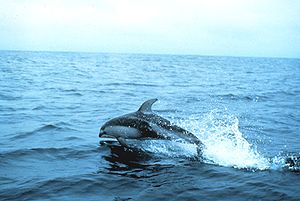White-striped dolphin
| White-striped dolphin | ||||||||||||
|---|---|---|---|---|---|---|---|---|---|---|---|---|

White-striped dolphin |
||||||||||||
| Systematics | ||||||||||||
|
||||||||||||
| Scientific name | ||||||||||||
| Lagenorhynchus obliquidens | ||||||||||||
| Gill , 1865 |
The white- striped dolphin ( Lagenorhynchus obliquidens ), also known as the Pacific white-sided dolphin , is a very active short- snouted dolphin that is native to the cold and temperate waters of the North Pacific .
features
When fully grown, the white-striped dolphin reaches a maximum length of 2.50 meters and a weight of 200 kilograms for the males and 2.30 meters and 150 kilograms for the females. Today one also assumes two different populations , with animals from the northern part of the distribution area being somewhat smaller than those from the southern part. The snout is very short. The fin is large and strongly curved, at the same time it has a very broad base.
The body of the animals is drawn in three colors. The chin, throat and belly are cream to gray-white while the muzzle, the flipper and the fin are two-tone light and dark gray. The flanks are largely light gray, with a significantly lighter stripe running from above the eye over the flank below the fin to the tail stalk, where it thickens. The eyes are surrounded by a gray ring. The individual color scheme varies considerably, even among closely related animals in a school.
Way of life
The white-striped dolphin is very active and sociable and also forms mixed groups with other small whales in the North Pacific. He also approaches boats and uses their bow waves to surf. The average group size is around 90 animals, but schools of more than 3,000 animals have also been observed. They are very lively and fast jumpers who also perform high jumps out of the water.
The representatives of this species feed mainly on schooling small fish and cuttlefish. Anchovies , hake and the squid Loligo opalescens were mainly found in stomach analyzes . They are opportunistic hunters and hunt mainly in the Epipelagial and on the upper limit of the Mesopelagial to a depth of about 200 meters. Their hunting times are between the evening twilight and the early morning hours.
Reproduction and development
The females reach sexual maturity at seven years of age and the gestation period lasts about a year. The life expectancy of the animals is estimated at over 40 years. The young are born with a body length of 80 to 120 centimeters. The mating season is assumed to be between late spring and early autumn; the animals are sexually mature from a length of 1.7 to 2.2 meters.
distribution
The range of the white-striped dolphins forms a wide arc from the cold to the temperate parts of the North Pacific. The southernmost parts are in the South China Sea on the Asian coast and Baja California on the American coast. There are also smaller populations in the Sea of Japan and the Sea of Okhotsk . The northernmost parts of the distribution area are in the Bering Sea .
The animals probably follow migratory routes, so one meets them on the California coast especially in winter and further north in summer in greater density, but animals are also present throughout the year. They always prefer open waters of the high seas , but can occasionally approach the coast.
Taxonomy
The first description of the white-striped dolphin was made in 1865 by Theodor Gill on the basis of three washed-up skulls in California. Both in terms of its morphology and genetically, the white-striped dolphin is very close to the black dolphin from the southern Pacific. These similarities led to the assumption that they are collectively only one species. However, the current opinion is that there are actually two separate species, but their formation only took place about two million years ago.
The scientific name was given due to the shape of the teeth. The species name obliquidens is derived from the words obliquus = oblique and dens = tooth.
Threat and protection
Estimates of the number of white-striped dolphins amount to a total population of around one million animals, making the white-striped dolphins one of the most common small whales in the temperate zone. Until the United Nations banned trawls in 1993, several thousand individuals were killed by fishing. Estimates amount to 50,000 to 90,000 dolphins in the years 1978 to 1990. Today some animals are still killed by Japanese fishermen. However, this hunt does not pose a threat to the population.
In addition to this targeted whaling, many white- striped dolphins fall victim to both the drift nets in the northern Pacific and the bag nets used for anchovy fishing . Occasionally dolphins are caught for scientific purposes and for dolphinariums. In captivity, they have lifetimes of over 20 years, but most animals die within the first year.
literature
- Mark Carwardine : Whales and Dolphins . Delius Klasing, 2008, ISBN 978-3768824736 (high quality guide)
- Mark Carwardine: Dolphins - Biology, Distribution, Observation in the Wild . Naturbuch Verlag, 1996 (informative illustrated book)
- Ralf Kiefner: whales and dolphins worldwide . Year Top Special Verlag, 2002, ISBN 978-3861326205 , (guide to the magazine " tauchen ", very detailed)
- Randall R. Reeves, Brent S. Stewart, Philip J. Clapham, James A. Powell: Sea Mammals of the World. A Complete Guide to Whales, Dolphins, Seals, Sea Lions and Sea Cows. Black, London 2002, ISBN 0-7136-6334-0 (guide with numerous pictures).
- Gérard Soury: The great book of the dolphins . Delius Klasing, 2000, ISBN 978-3768810630 , (detailed illustrated book)
- Maurizio Wurtz, Nadia Repetto: Underwater world: Dolphins and Whales . White Star Guides, 2003, ISBN 88-8095-943-3 (identification book)
Web links
- Lagenorhynchus obliquidens in the endangered Red List species the IUCN 2006. Posted by: Cetacean Specialist Group, 1996. Retrieved on 12 May, 2006.


